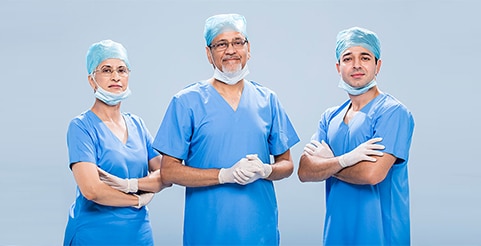Lungs and what happens when they are not healthy?
The lungs are a pair of spongy, air-filled organs located on either side of the chest. Our lungs are tasked with the vital job of providing oxygen that the body needs and removing the carbon dioxide that is toxic to the body.
While our lungs work normally, we are rarely aware of our breathing but when our lungs are forced to work harder to supply oxygen and eliminate the carbon dioxide, we feel shortness of breath. This requires the body to spend extra energy on breathing and may cause constant fatigue, which diminishes one’s quality of life. If the lungs get damaged beyond a point when even extra oxygen and other therapies fail, a lung transplant becomes the final treatment
option to experience a normal lifestyle.
A number of diseases and conditions can cause the lungs to become unhealthy and result in deterioration over time. These include:
- Chronic Obstructive Pulmonary Disease (COPD)
- Interstitial Lung Diseases (ILD) including Pulmonary Fibrosis
- Sarcoidosis
- Cystic Fibrosis
- Bronchiectasis
- Primary Pulmonary Hypertension
- Lymphangioleiomyomatosis (LAM)
- Langerhans Cell Histiocytosis (PLCH)
- Pulmonary Alveolar Microlithiasis
- Pulmonary Alveolar Proteinosis
- Congenital Heart Disease with Eisenmenger syndrome
- Other diseases causing end-stage lung failure
One may require either a single lung transplant or a double/bilateral lung transplant) and, in certain cases, a combined heart and lung transplant.
To be a candidate for a lung transplant, one must:
- Have a condition for which transplantation is considered an effective treatment
- Have severe and progressive lung disease that no longer responds to other medical treatment
- Be willing to accept the risks of surgery and subsequent medical treatments
- Be physically and mentally capable of undergoing surgery and subsequent medical treatments
- Not a smoker and/or abuse alcohol or drugs
Accepted for Lung Transplant, What Next?
Once a patient is accepted as a candidate for lung transplant, they will be placed on the waiting list for a new organ. During this waiting period, the following will be done:
- An evaluation will be performed through lab tests
- The patient will undergo regular pulmonary rehabilitation coupled with exercise and good nutrition, monitored by pulmonary rehabilitation specialists
- Be counselled along with their family members at regular intervals about what to expect before, during and after lung transplantation
- Be put in touch with social and financial coordinators for help with logistical issues
Standard Pre-Transplant Testing:
Lungs
- Chest CT to get a 3D X-ray image of the lungs
- Pulmonary Function Test to measure lung function
- Ventilation-perfusion Scan to determine the degree of irreversible damage to the blood and air supply of each lung
Heart
- ECG to record the rhythm of the heart
- ECHO Doppler to look at the heart size and how the heart muscle and valves are working
- Cardiac catheterisation to measure the blood pressures in the lung and the heart
Others
- Lab tests to determine functions of various organs, immune status and other parameters
- Cardiopulmonary Exercise Testing to evaluate exercise capacity and predict outcomes in patients with heart/lung failure
Pre-Transplant Patient Education
While on the waiting list, the patient and members of their immediate family will be
- Counselled by the transplant surgeon about lung transplant and answer any questions. Aside from this, the patient’s will also be required to seek counselling regarding other aspects:
- Dietary consultation: The dietitian will perform an assessment of the weight, height, body muscle and fat stores and will review the patient’s dietary history in detail. Nutritional status is important in maintaining one’s health during the waiting period, lowering the risk of surgery and aiding in recovery.
- Psychological assessment: Undergoing major surgery like a lung transplant can be quite stressful. It is thus mandatory to undergo psychological assessment to review the patient’s cognitive and emotional functioning.
- Financial Counselling: The estimated cost of the surgery, payment options and financial planning will be discussed with the patient and their family.
Lung transplantation has the potential to lengthen life expectancy and substantially improve one’s quality of life. The first year after a lung transplant is the most crucial as this is when surgical complications, organ rejection and infections pose the greatest threat to survival. This is why following the post-transplant instructions given by the transplant surgeon about taking the necessary medication regularly and following hygiene protocols is important.
Patients who survive the first year can easily survive 5 years or longer after transplantation. The primary goal is to achieve improved lung function, live a better quality of life and experience a relatively normal lifestyle.
While there are many benefits, there are also risks that accompany major surgical procedures like lung transplantation:
Rejection
A common medication prescribed post-transplant is an immunosuppressant. As the transplanted lung(s) is foreign to the body, it is natural for the body’s immune system to fight against it, resulting in organ rejection. To prevent this, the immune system is suppressed to control the rejection process. Signs of rejection include:
- Fever, cough, difficulty breathing
- Decrease in pulmonary function tests
- Elevated white blood cell count
- Abnormal chest X-ray
Infection
The downside to taking immunosuppressants is that the immune system will be less capable of fighting off infections, thereby making the patient more susceptible to infectious diseases. To prevent this, the immunosuppression is balanced with anti-infective prophylaxis.
Post-transplant, the patient is first shifted to the Transplant ICU for close monitoring by specialist transplant nurses. The patient might be put on a mechanical ventilator for a few days to help them breathe. Once the patient’s conditions improve, they are taken off the ventilator and transferred to the ward, where they will remain for another one to three weeks.
Once discharged, frequent monitoring by the transplant team is required. The patient will be instructed not to lift anything greater than 5 kg for the first six weeks after surgery and not participate in strenuous activity. Pulmonary rehabilitation therapy will be prescribed twice a week. Follow-up visits will include lab tests, chest X-ray, pulmonary function tests and ECG.
When to call the doctor?
Being faced with unknown symptoms post-transplant can be overwhelming for both the patient and their family. Before the patient is discharged from the hospital and during every follow-up visit, they will be trained on what signs to look out for by the transplant nurses. Medical attention should be sought out for the following reasons:
- Fever over 99.6oF
- Fatigue or general ache in muscles and joints
- Cough or shortness of breath
- Blood in the stool
- Nausea, vomiting or diarrhoea
- Chills
- Redness, swelling, pus, drainage or pain at the incision site


 In-person Consultation
In-person Consultation Online Video Consultation
Online Video Consultation Treatment Enquiries
Treatment Enquiries Find a Doctor
Find a Doctor Access the Patient Portal
Access the Patient Portal +91 44 4524 2407
+91 44 4524 2407  Minimal Access GI & Bariatric Surgery
Minimal Access GI & Bariatric Surgery Multi-Visceral and Abdominal Organ Transplant
Multi-Visceral and Abdominal Organ Transplant Neurology
Neurology Spine Surgery
Spine Surgery Total Knee replacement
Total Knee replacement Anaesthesiology & SICU
Anaesthesiology & SICU Paediatric Cardiology
Paediatric Cardiology Emergency Na MGM
Emergency Na MGM IVF
IVF Oncology Treatments
Oncology Treatments







